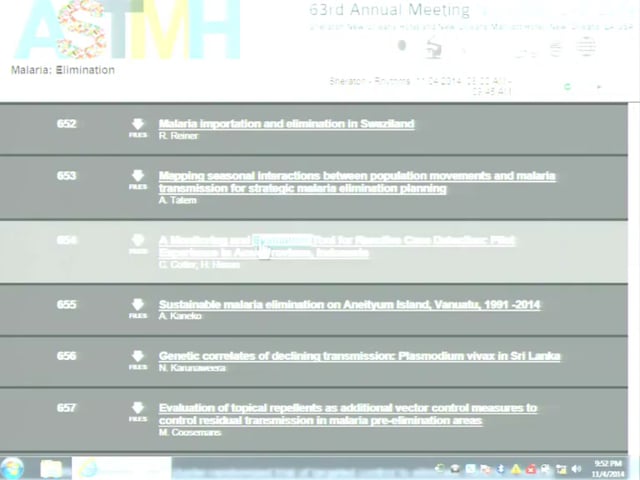ASTMH 2014, Akira Kaneko: “Sustainable malaria elimination on Aneityum Island, Vanuatu, 1991 -2014”
Collaborator(s): Karolinska Institute (KI), Sweden; Ministry of Health (MOH) Vanuatu, Vanuatu; Nagasaki University, Japan; University of Sri Jayewardenepura, Sri Lanka; London School of Hygiene and Tropical Medicine (LSHTM), United Kingdom; Binghamton University, United States; Stockholm University (SU), Sweden;
Countries: Vanuatu
Published: 01/11/2014
In collaboration with ASTMH, ImageAV & presenters, MESA brings you this webcast.
Title: Sustainable malaria elimination on Aneityum Island, Vanuatu, 1991 -2014
Abstract:
This talk forms part of the Scientific Session on ‘Malaria Elimination’ at ASTMH. Weekly mass drug administration (MDA) of chloroquine, pyrimethamine/sulfadoxine, and primaquine was carried out on the entire population of 718 inhabitants of Aneityum island for 9 weeks in 1991 before the onset of the rainy season. Simultaneously insecticide-treated bednets (ITNs) were distributed to the entire population. Microscopy showed the immediate disappearance of Plasmodium falciparum, whereas P. vivax disappeared from 1996 onwards until new cases were reported in January 2002. In July 2002 P. vivax infections were detected by microscopy in 22 of 759 individuals: 20/298 born after 1991, 2/126 born between 1991-82, and 0/335 born before 1982. Subsequent PCR increased the total to 77 (36, 21, and 20 in respective age groups). The age distribution was similar to those before elimination and on other islands. In November a similar age pattern was found but with fewer (39) infections. In December 2002, the 2nd MDA of weekly chloroquine for four weeks and daily primaquine for 14 days was carried out as a containment measure on the population born after 1982, in concert with re-strengthening of the community-based provision of ITNs. Population-wide mass blood surveys detected by PCR no cases in December 2002 (n=436, only those born after 1982), immediately after the MDA, but 26 in 2003 (730), 20 in 2004 (732), 34 in 2005 (836), and 15 in 2007 (719). No positive cases were detected in 2010 (950) and 2013 (1093). The age distribution of 2003-2007 positive cases was different from those before elimination and on other islands: i.e. a substantially lower prevalence was observed in the population born after 2002 (0.8%) than those between 2002-1992 (3.7%), between 1991-1982 (5.3%), and before 1982 (2.1%), suggesting that these submicroscopic infections mainly reflected relapses from liver stages. Sero-epidemiological monitoring suggested that the persistence of antibodies against P. vivax may partially explain the lower parasite prevalence in the oldest age group. On Aneityum, indigenous P. falciparum transmission has never re-established after the 1st MDA in 1991, despite surveillance by community microscopists that showed continuous parasite importation from other islands. A high degree of community engagement to prevent resurgence, in addition to high ITN coverage (1.05 net/person) and usage (95%, 2014), sustains malaria freedom on this island.



